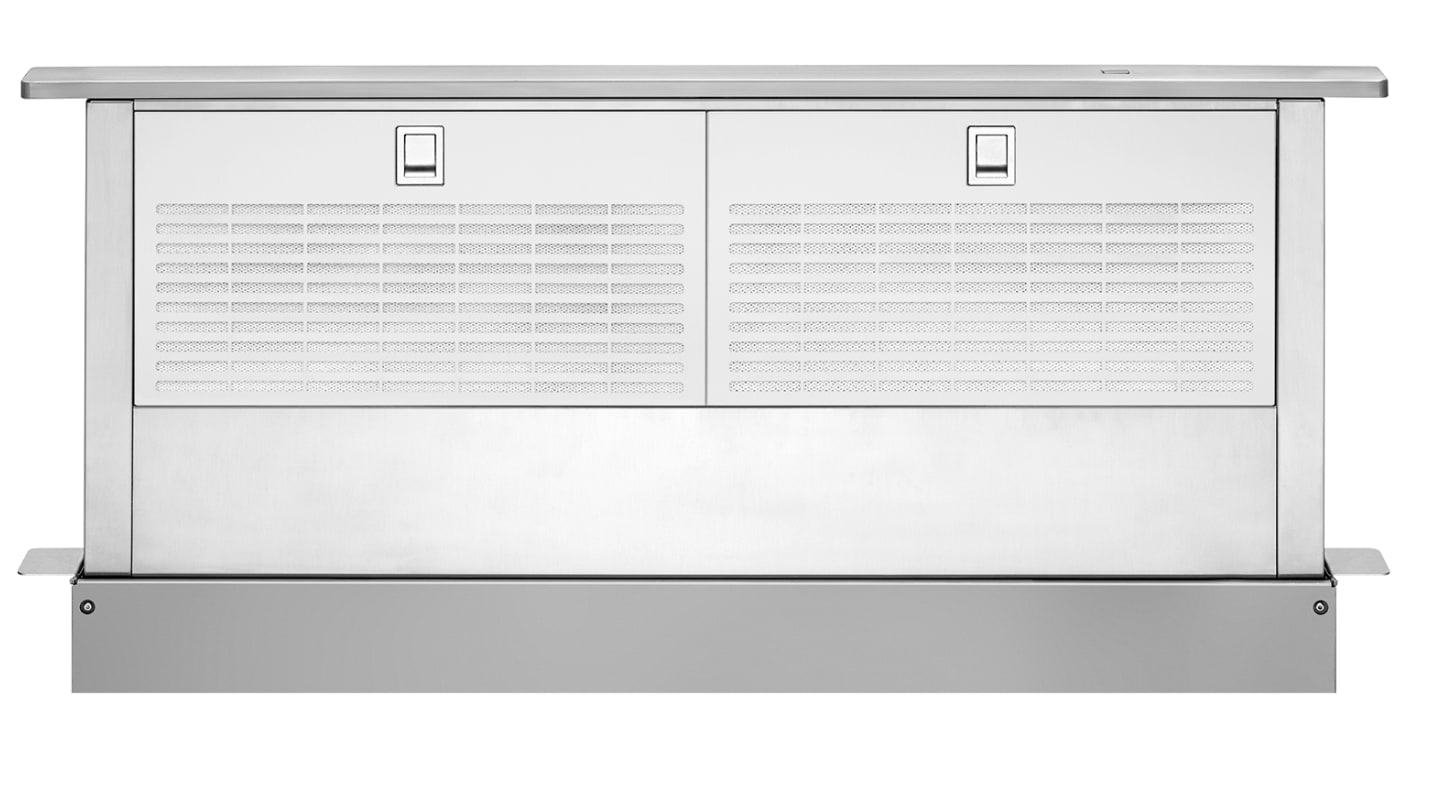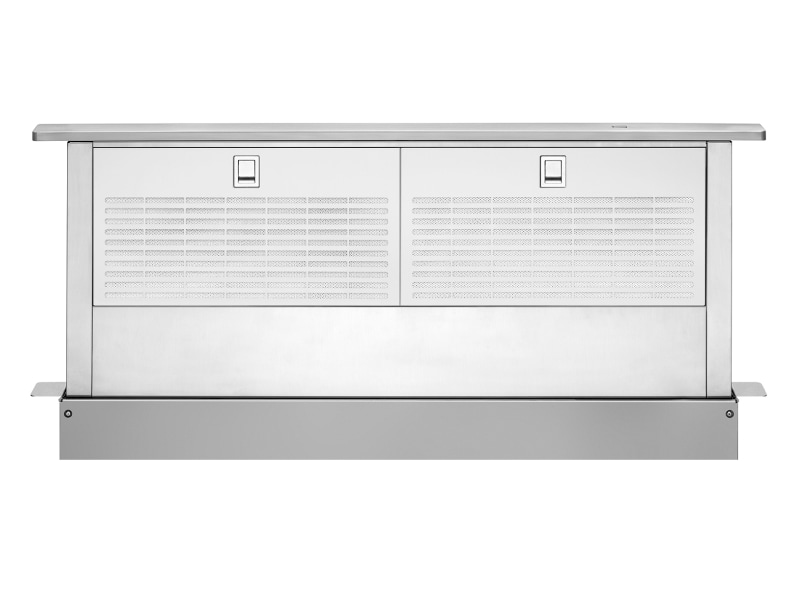
TYPES OF COOKTOPS EXPLAINED: WHAT TO KNOW BEFORE YOU BUY
A cooktop, or stovetop, is a stand-alone appliance that installs directly into your countertop. Cooktops look like the stovetop on a range but are separate from the oven. A range, on the other hand, includes both an oven and a cooktop in one appliance.
Many people opt for a cooktop plus wall oven configuration because they find it convenient to separate stovetop and oven functions, they prefer the aesthetics, or they want to install the cooktop somewhere a range may not work, like certain kitchen islands.
Installing a separate cooktop and a wall oven allows you to increase the height of your oven, eliminating the need to bend down to put food inside.
If you’ve never considered a stand-alone cooktop, you might find that it suits your needs, with electric, gas, induction and downdraft cooktop styles available. Some cooktops even come equipped with additional accessories like grills and griddles. Read on to learn more about the different types of stovetops for your kitchen.
4 TYPES OF COOKTOPS
Several different cooktops are available on the market, including gas, electric, induction and downdraft. Cooktops are usually set apart by their fuel source and how they heat your food. For instance, a cooktop can be powered by electricity, gas or propane. Many cooktops are approximately 30 to 36 inches in size and come with four to six burners. Larger cooktops, up to 48 inches, are available and generally come equipped with more burners. Learn more about cooktop sizes and dimensions.
Gas, electric and induction cooktops each heat your food differently, which is another factor to keep in mind. Gas cooktops use an open flame to heat your food, while electric cooktops use a radiant, smooth top to heat your food. Induction cooktops use electromagnetism and require specific, induction-compatible cookware.
Modular cooktops are a unique choice that allow the consumer to customize the cooktop to include different cooking elements.
Read on to learn more about the different types of cooktops and how they work.


1. GAS COOKTOPS
Gas cooktops use natural gas or liquid propane in an open flame to cook food. They offer responsive control over heat adjustments since the flame can be adjusted instantly, and you don’t need to wait for a heating element to heat up or cool down. Because you can see the color and size of the flame, you have a clear idea at all times of how your food is being heated. An open flame is also able to reach up the sides of some pans, which can be a benefit when cooking with sculpted pans such as woks. In order to install a gas cooktop, your kitchen needs to have a gas line.
SHOP MAYTAG® GAS COOKTOPS
Maytag® gas cooktops bring powerful features and durability to your kitchen. Select models from Maytag brand feature a 15,000-BTU Power™ Burner to allow for a slow, even sauté and the intense heat for a seared, juicy steak and DuraClean™ Continuous Cast Iron Grates that let pots and pans smoothly slide around the cooktop for fewer spills and easier transitions from burner to burner.

2. ELECTRIC COOKTOPS
Electric cooktops are either radiant or induction. While both types use electricity instead of gas, the term “electric cooktop” generally refers to an electric radiant cooktop. Electric radiant cooktops cook food using heated metal coils or heating elements often housed in a flat glass or ceramic surface. They’re good for bringing water to a boil, as they focus heat directly on the bottom of the pot rather than around it. Plus, they work with nearly any type of cookware.
Electric cooktops featuring a glass or ceramic top are also easy to clean due to their smooth, flat surface. In order to keep from scratching your electric cooktop, you may need to use a special cleaner. Learn more about electric cooktops as well as the benefits of gas and electric stoves.
SHOP MAYTAG® ELECTRIC COOKTOPS
Maytag® electric cooktops offer the flexibility and durability to handle whatever’s on the menu. On select models, the 10/6-inch Dual-Choice™ element or 12/9-inch Dual-Choice™ element gives you the ability to cook with the pan you want and the power you need. The hot surface indicator light illuminates when your electric cooktop surface is hot to the touch, even after the heating element has been turned off. Some models include the Maytag® Exclusive Electric Cooktop with Reversible Grill and Griddle, so you can boil, pan fry, grill, sear, flip and griddle.

3. INDUCTION COOKTOPS
An induction cooktop is a type of electric cooktop that uses electromagnetism to heat cookware, essentially turning the cookware into its own source of heat. The cooktop surrounding the element does become hot but generates heat through an electromagnetic reaction directly in the pot or pan. The system allows for a rapid rise or drop in temperature. This often leads to faster cooking, especially in saucepans and pots—water will usually come to a boil much faster on most induction cooktops. Another benefit of an induction cooktop is the lack of an open flame or hot cooktop surface to keep an eye on. Compare induction vs. gas cooktops to find the best fit for you.
Keep in mind that you can't use aluminum or copper cookware on an induction cooktop. To determine if your cookware is induction-compatible, simply hold a magnet to the bottom. If the magnet clings, the cookware is likely induction-compatible. Many induction-compatible cookware options are now labeled by the manufacturer as such, as well.
SHOP MAYTAG® INDUCTION COOKTOPS
Maytag® induction cooktops deliver hardworking features designed to handle both the mess and the meal. On select models, SmartBoil delivers consistent heat that keeps boil-overs to a minimum, and TempCook™ automatically adjusts power levels to help prevent overcooking or undercooking. Select models feature No Guess Presets that set the cooktop to the exact results you want with one-touch cooking modes like boil, sauté and simmer, and the XL Cooking Zone, which evenly heats even your largest cookware.


4. DOWNDRAFT COOKTOPS
A downdraft cooktop can come in a gas or electric configuration, and it integrates the ventilation system directly into the cooking surface, eliminating the need for an overhead vent. Downdraft cooktops are a good option if you’re installing your cooktop on a kitchen island where there isn’t room for a hood, or if you just like an open feel to your kitchen. Keep in mind that you’ll need under-counter cabinet space to house internal components essential to the operation of a downdraft cooktop.
SHOP MAYTAG® DOWNDRAFT HOODS
Maytag® retractable downdraft hoods stay flush with the cooktop surface until needed, then rise to help capture smoke and steam. A reversible motor box can be installed on either side to maximize cabinet space below.
COOKTOP FEATURES
Some stovetops come with special features that enhance the cooking experience. These special features may include:
- A stovetop or reversible grill and griddle, allowing you to make pancakes or burgers right on your cooktop
Burners with extra heat output to help speed up time-consuming tasks like boiling water or searing meats. For example, the Power™ Burner on select Maytag® cooktops allows for a slow, even sauté and the intense heat needed for a seared, juicy steak.
Extra burners for the flexibility to prepare all your meals without juggling pots and pans
Flexible burner sizes to help you match heat output to the cookware you're using. For instance, the 10/6-inch or 12/9-inch Dual-Choice™ Elements on select Maytag cooktops give you the ability to cook with the pan you want and the power you need.
Features that deliver consistent heat to help reduce boil-overs and spills. Some Maytag® cooktops are equipped with a SmartBoil feature that maintains an even temperature to help keep spills to a minimum.
Features that automatically adjust heat levels to help take the guesswork out of cooking. On select Maytag® cooktops, TempCook™ helps prevent overcooking or undercooking by managing power levels for you.
Larger heating elements that work well for oversized cookware or big-batch cooking. The XL Cooking Zone featured on select cooktops by Maytag brand provides even heating for your largest pots and pans.
A hot surface indicator light. On select Maytag® cooktops, the Hot Surface Indicator Light illuminates when your electric cooktop surface is hot to the touch, even after the heating element has been turned off.
Continuous grates to help provide a smooth cooking surface that supports easy movement. On select cooktops by Maytag brand, DuraClean™ Continuous Cast-Iron Grates let you slide pots and pans across the cooktop.
Easy-to-clean surfaces to help speed up kitchen cleanup. Enjoy a Fast-Cleaning Cooktop on select Maytag brand models that cools down fast and repels stains, scratches and chipping.

Maytag® cooktops
One cook space, full-meal power
Whether you’re working with a small space or just want more room for cooking, Maytag® cooktops offer power, durability and performance for every meal
HOW TO CHOOSE A COOKTOP
Start by thinking through a few key considerations like how much you want to spend, where you have space available in the kitchen and which types of burners you like to use.

BURNER TYPE: GAS, ELECTRIC OR INDUCTION
Choose between gas, electric or induction burners. Most kitchens are set up for an induction or electric cooktop—all you need is an outlet. To install a gas cooktop, you’ll need a dedicated gas line, which can be installed for an additional cost if you don’t already have one.

AVAILABLE SPACE IN THE KITCHEN
Going with a cooktop plus wall oven configuration may take up more space overall than a traditional range, but it also offers more flexibility. Cooktops can work in kitchens of all sizes as they range in size from 15 inches to 36 inches wide. Make sure you have the space you need for two different appliance installations. The number of burners featured on cooktops can range from two to five, or more.
Consider your available surface space as well when choosing a cooktop, and explore Maytag’s selection of 4-burner and 5-burner cooktops to see what’s right for you. Remember to accurately measure your available space before you decide on a cooktop.

PRICE: COOKTOPS VS. RANGES
Cooktops are a little more affordable than a range, but keep in mind that you’ll also need to budget for an oven. For example, Maytag® cooktops have a range of around $850 to $1,400. Gas and electric cooktops have similar price ranges, but expect to pay more for induction and downdraft models, as well as cooktops with larger widths and more features.
Need to install a new cooktop in your countertop? Read this Maytag® guide to cooktop replacement and installation.
SHOP MAYTAG® COOKTOPS
Maytag brand offers hardworking induction, gas and electric cooktops with features like the Power™ Burner, which allows for a slow, even sauté and the intense heat for a seared, juicy steak, or the Maytag® Exclusive Electric Cooktop with Reversible Grill and Griddle that can help you boil, pan fry, grill, sear, flip and griddle.


